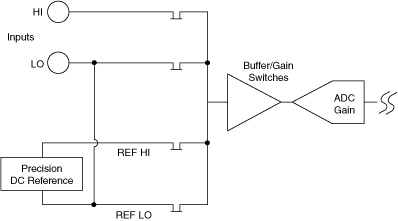ADC Calibration
ADC calibration, a method used to compensate for an internal DMM gain error, is a feature exclusive to the NI 4070/4071/4072 DMM that allows you to appropriately trade off measurement speed for long-term accuracy. The NI 4070/4071/4072 ADC is designed for precision, linearity, and stability. By doing routine calibration of the ADC back to a single well-controlled component, you can ensure absolute accuracy of the conversion.
In DCV and resistance at 6½ or 7½ digit resolutions, NI recommends using ADC calibration for the greatest accuracy. In ACV and current, or at resolutions of 4½–5½ digits, ADC calibration is not required for satisfactory performance. When ADC calibration is enabled, every measurement cycle includes an additional phase for acquiring the value of the high-precision reference. This phase yields the most exacting precision because any ADC gain drift is normalized to the input signal, and the ADC gain drift is removed in the resulting mathematical calculation on every measurement.
Traditional methods disperse these measurements over time—compromising performance, speed, and deterministic timing. For optimum drift performance, NI recommends using ADC calibration as part of each measurement cycle.
Your application may demand speed over accuracy. In these instances, you can disable ADC calibration.
The following figure represents the process of the ADC calibration cycle. During this cycle, the input is disconnected from the ADC and the precision DC reference is measured. This measurement consists of an ADC calibration Auto Zero (REF LO) and an ADC calibration HI (REF HI). The normalized value of the reference voltage is calculated from Vref = REF HI–REF LO.

With ADC calibration disabled, the measurement speed increases by a factor of up to two and you need to add a temperature coefficient error of 3 ppm/ºC to the appropriate range specification. Although the error is small, you should still consider the effects. Long-term drift typically degrades by 50 ppm/3 month. If you need to turn off ADC calibration, as you might when you want optimum speed in 6½ or 7½ digit resolution, you can recover to specified accuracy by running periodic self-calibration operations.
 |
Note NI recommends that you run self-calibration before taking a 6½ or 7½ digit measurement with ADC calibration disabled. |
The measurement effect of ADC calibration decreases as your selected digits of resolution decreases.